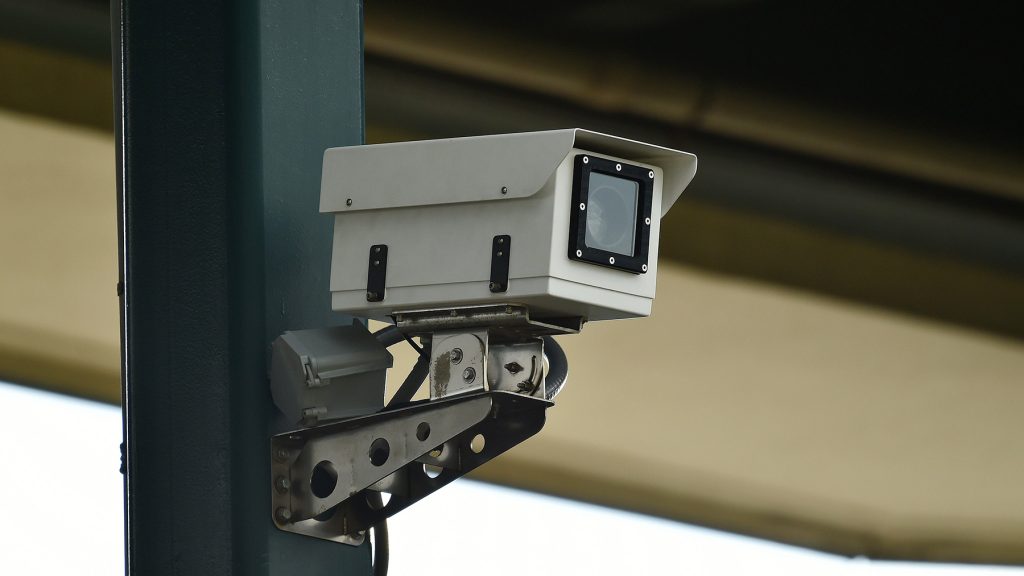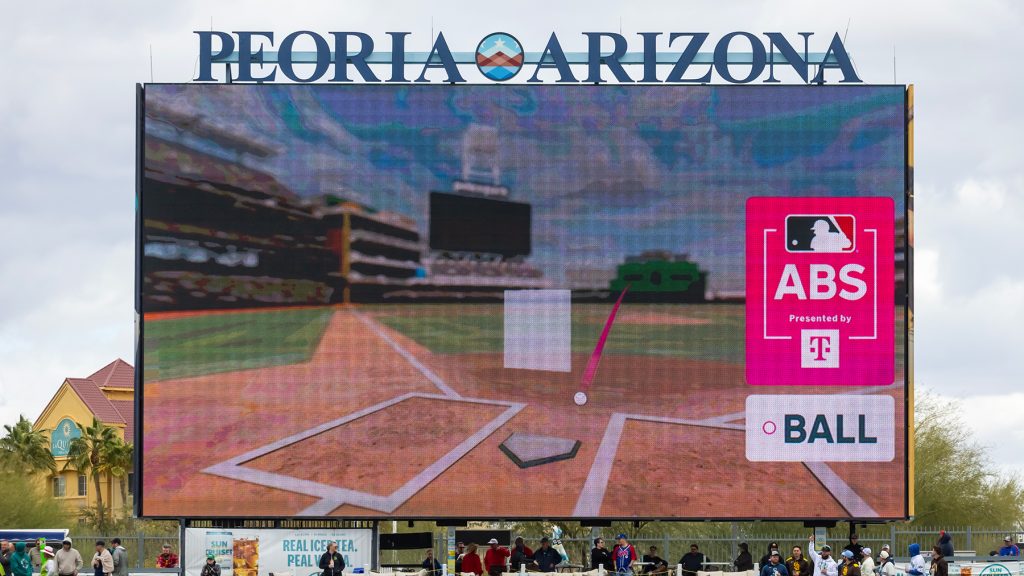Man vs. Machine: MLB’s Automated Ball-Strike Spring Experiment Shows Game’s Evolution
GOODYEAR, Ariz. — As the shadows grew longer on a spring March afternoon at Goodyear Ballpark, Cincinnati Reds pitcher Brady Singer tilted his body and launched a four-seamer into the corner of the zone: ball four. Seattle catcher Harry Ford trotted down the first-base line, putting two runners on with no outs, possibly souring another afternoon for the 28-year-old righty.
Singer then, simply, tapped his hat.
Eliciting a groan from some baseball purists and your grandfather’s recliner, the scoreboard flashed the strike zone, and the crowd watched as the pitch’s true location was displayed. With the bold lettering of “strike,” Singer smirked.
Vindication.
Twenty years ago, that series of events would’ve made your eyes peel through the crowd for Marty McFly, but with athletics evolving, it’s about time Major League Baseball took a step forward. In one of its biggest advancements in years, MLB tested the Automated Ball-Strike system (ABS) in spring training, and while there’s not yet a set date for when it’ll arrive in regular-season games, there’s little doubt it’s coming.
“It’s been fun. It’s been entertaining,” Mariners pitching coordinator Quinn Cleary said. “I think having the challenge gives players the opportunity to find that one key moment in the game, like, ‘Oh, this is a pitch I want to challenge.’”
In almost any MLB locker room, a similar sentiment to Cleary’s reverberates: Challenging pitches is effective. But that shouldn’t come as a surprise.
While the top of the MLB pyramid didn’t have experience with the robot-like challenge system until February, the minors — specifically all of Triple-A, where the MiLB tested it for the entirety of the 2023 and 2024 campaigns — have been batting around with the concept for years.

The first test run was one of full ABS, essentially using a computer system to call every pitch, in the Independent Atlantic League in 2019. That wasn’t very functional. Players and fans had a mutual distaste for the lack of a human element to umpiring, not to mention games got notably longer due to a rise in walks. But just as any good experiment would, the MiLB went back to the drawing board and settled on a revised challenge-based system, which it first employed in the Florida State League in 2022. With its success there, it jumped through the minor leagues.
“I like ABS,” Athletics pitcher Justin Sterner said. “It helps with a lot of things, holding umpires accountable. I just definitely don’t support full ABS.”
That’s a demarcation every player makes, with the MLB finding that only 11% of players support “full” ABS. So what’s the difference between the current ABS being tested and “full” ABS? An entire ABS umpire system would call every pitch dependent on a set box. That’s what the Atlantic League tested to much uproar. What the MLB is proposing serves almost as a compromise.
Tested across 13 MLB spring training venues — five in Arizona and eight in Florida — ABS functioned as a challenge system. Only the batter, the catcher and the pitcher are allowed to, but if they believe the umpire made an incorrect ball-strike call, they can challenge by tapping their hat or helmet. At that point, stadiums turn into a game show: Who wants to have a strike?
A camera-computer system rapidly reviews the ball’s location, and everyone in attendance watches the scoreboard for the result. Each team starts the game with two challenges, and they keep every challenge they get correct.
“It isn’t useful all the time,” Athletics first baseman Tyler Soderstrom said. “But in those moments where you really think you’re right, it’s great.”
According to data released at the end of March by MLB, 52.2% of all ball-strike challenges this spring resulted in a successful challenge and overturn of the umpire’s original call
Of those, 54.4% of challenges by pitchers were overturned. For hitters, the clip was dead even at 50%, with teams combining for 1,182 challenges across 288 contests (4.1 per game). But that doesn’t necessarily mean either has better adjusted to the automated system. It depends on the moment.
The spring test showed players were more inclined to challenge pitches in higher-leverage counts, but that didn’t yield success. Only 44% of 2-2 and 3-2 pitch count challenges were successful. Additionally, later in games, players became less thoughtful about their challenges. Sixty percent of challenged calls were overturned in the first three innings, as opposed to 51% in the fourth through sixth and 43% in the seventh and eighth. So, after years of argument about how umpires struggle with accuracy in high-pressure situations, players — unsurprisingly — experience the same difficulties.

“That’s the thing with pitchers. They can get too emotional,” Phillies reliever Max Lazar told The Athletic. “Maybe, like, right after an error, or they don’t like a [ball-strike] call, or they just got two or three [calls] in a row they didn’t like, so they … try to steal one back [by challenging].”
While not an apples-to-apples comparison, the success rate of pitch challenges in MLB (52.2%) sat well below situational challenge rates in the NFL and NBA from this year. Players in all sports are “emotional,” so what’s the reason for the difference?
For some, especially pitchers, there have been noticeable adjustments to their approaches to at-bats, especially considering the size of the strike zone. Generally, umpires employ a slightly oval zone that gives an inch or two in each direction. ABS doesn’t care what Ángel Hernández would’ve called, though.
“You’re having hitters that are walking a lot more. You see on base percentages go up a lot, which makes a pitcher’s life that much tougher,” Braves pitcher Hurston Waldrep said. “So when you’re pitching to an ABS strike zone, the zone feels tiny, and that makes our lives more stressful in the end.”
However, for catchers, the threat of ABS looms more mightily. For nearly a century, those behind the plate have become a type of magician, fine-tuning a sleight-of-hand, brief motion to frame pitches. According to Mariners pitcher Jackson Kowar, it’s “a real art form,” as he witnesses how his catchers develop their ability to perform a sort of pitch transformation.
With ABS, there’s slightly less value to pitch framing, as the computer, unlike an umpire, can’t be tricked into committing a human error, even though teams can only challenge so many calls. But that doesn’t mean catchers are losing their value. If anything, it could be growing.
Catchers are positioned to determine most accurately if an umpire was right or wrong about a call, multiple players emphasized. While it may take some time to adjust and test the boundaries of the ABS strike zone, catchers could develop the strongest understanding of how to use ABS to their advantage, holding umpires accountable.
“I like it,” Braves catching prospect Drake Baldwin told The Athletic. “If I just have a gut feeling about a big pitch, if I think it clipped a corner or something, I’ll challenge it. And I think it’s a cool aspect of the game.”

That skill is already noticeable, as catchers had the highest success rate on challenges during spring training at 56%.
With its spring training test run concluded, ABS will stoop back into its Triple-A hibernation, but not without glowing recommendations. The survey showed 61% of team personnel, including players, and 47% of fans prefer the challenge system, according to MLB’s research team.
“Reaction certainly from fans has been overwhelmingly positive,” MLB commissioner Rob Manfred told The Associated Press. “I think that there’s confirmation that the use of the technology and the renderings and the scoreboard is really a fan engagement addition that people really like.”
So, at last, here steps MLB into the modern world. A sport that’s been plagued by a lack of timeliness for years, resulting in a steady viewership drop throughout the 2010s, is slowly adjusting. While the ABS system might not be perfectly fine-tuned and won’t elicit the rattling change of the pitch clock, Aaron Judge and other MLB stars will surely care when they strike out because of a challenge. Waldrup, Sterner and Singer do, at least every time they get a strike back.
More CJCxARZ Spring Training Coverage:
* More Than Words: Inside the Important, Unique — And Sometimes Random — Role of MLB Translators
* Jurrangelo Cijntje, Seattle’s Switch-Pitching Wonder, takes the Minor Leagues By Storm
* The Unconventional Angle: The Rare Commodity, Craft of Baseball’s Sidearm Pitchers
* The Importance of Spring Training: How it Shapes Players of All Levels
Category: Athletics, Cactus League, Cincinnati Reds, Top Stories
Tagged: ABS Brady Singer Spring Training 2025


